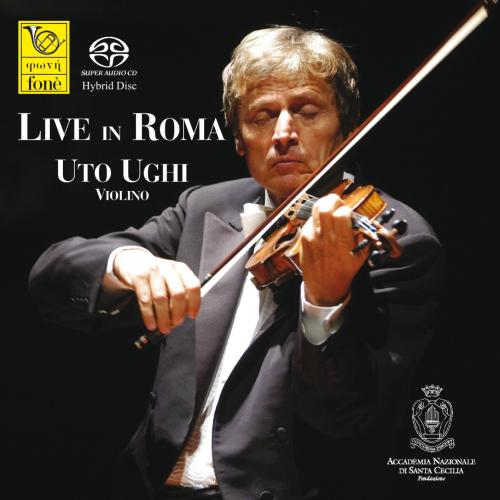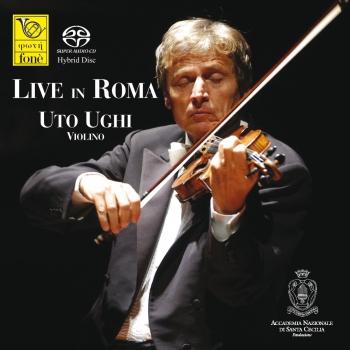
Live in Roma (Remastered) Uto Ughi
Album Info
Album Veröffentlichung:
2021
HRA-Veröffentlichung:
08.10.2021
Das Album enthält Albumcover Booklet (PDF)
- Johann Sebastian Bach (1685 - 1750): SONATA N. 1 IN SOL MINORE BWV 1001:
- 1 SONATA N. 1 IN SOL MINORE BWV 1001 - ADAGIO 03:55
- 2 SONATA N. 1 IN SOL MINORE BWV 1001 - FUGA. ALLEGRO 05:22
- 3 SONATA N. 1 IN SOL MINORE BWV 1001 - SICILIANA 03:31
- 4 SONATA N. 1 IN SOL MINORE BWV 1001 - PRESTO 03:18
- PARTITA N. 2 IN RE MINORE BWV 1004:
- 5 PARTITA N. 2 IN RE MINORE BWV 1004 - ALLEMANDA 03:07
- 6 PARTITA N. 2 IN RE MINORE BWV 1004 - CORRENTE 02:04
- 7 PARTITA N. 2 IN RE MINORE BWV 1004 - SARABANDA 02:48
- 8 PARTITA N. 2 IN RE MINORE BWV 1004 - GIGA 02:10
- 9 PARTITA N. 2 IN RE MINORE BWV 1004 - CIACCONA 13:46
- Eugène-Auguste Ysaÿe (1858 - 1931):SONATA N. 4 IN MI MINORE OP. 27:
- 10 SONATA N. 4 IN MI MINORE OP. 27 - ALLEMANDA 04:58
- 11 SONATA N. 4 IN MI MINORE OP. 27 - SARABANDA 03:01
- 12 SONATA N. 4 IN MI MINORE OP. 27 - FINALE 03:19
- Niccolò Paganini (1782 - 1840):CAPRICCIO:
- 13 CAPRICCIO N.1 - ANDANTE IN MI MAGGIORE 01:54
- 14 CAPRICCIO N.9 - ALLEGRETTO IN MI MAGGIORE 03:08
- 15 CAPRICCIO N.13 - ALLEGRO IN SI BEMOLLE MAGGIORE 02:48
- 16 CAPRICCIO N.15 - POSATO IN MI MINORE 03:18
- PAGANINIANA:
- 17 PAGANINIANA 05:07
Info zu Live in Roma (Remastered)
This album was recorded during a live concert held at the Auditorium Parco della Musica - Sala Petrassi in Rome on November 12th, 2004.
Recording and production are by Giulio Cesare Ricci in collaboration with the National Academy of Santa Cecilia - Foundation.
The great violinist Uto Ughi during the concert played the Guarneri del Gesù violin, ex Grumiaux, masterfully interpreting some of his "masterpieces" such as the Concerto in la min. n.1 per violino e archi BWV 1041 - J.S.Bach, il Concerto in re min. n.4 per violino e Orchestra - N.Paganini and an emotional Meditation da "Thais" per violino e Orchestra - J. Massenet.
Finally, the repertoire of this album is also enriched by the Symphony Op. 3 n.1 - C. Bach.
The choice of this location was dictated by its particular acoustics which allowed to obtain a very special result.
For this recording Giulio Cesare Ricci used the original tube microphones Neumann U47, U48 and M49 and all its equipment: mike pre-amplifiers, line, digital, microphone and supply cables Signoricci.
Recorded in Stereo DSD on Pyramix using dCS A/D and D/A converters.
Also for this recording Giulio Cesare Ricci used a "field effect" recording technique, natural sound, without the use of equalizers, no sound expansion and compression systems.
With this recording, Giulio Cesare Ricci wanted the listener to live a unique experience: it is as if he were sitting on an armchair positioned in the ideal position of the "Sala Petrassi - Auditorium Parco della Musica".
In this position, the depth, width and height of the sound are very appreciated.
Uto Ughi, violin
Uto Ughi
trained initially in Siena and one of George Enescu’s last pupils in Paris, is a violinist of distinctive character. Some will enjoy the depth of his tone—dark and rich on the lower strings, with a mighty and conspicuous vibrato—whilst others may find his approach overblown, leaving not enough to the listener’s own imagination. Certainly, Ughi is an extreme example of post-war trends in violin playing and his is an approach that will not previously have been heard upon the two historic instruments in his possession: the 1701 ‘ex-Kreutzer’ Stradivari and the 1744 ‘ex-Grumiaux’ Guarneri.
Aesthetic judgements aside, Ughi’s intonation—sharp in high registers, especially—will be problematic to many ears; this is not helped by the use of vibrato in passagework (a fashion often ascribed to Kreisler but in fact rather more a habit of later twentieth-century players).
Ughi’s Bach A minor Concerto (2005) is richly played, with steady tempi and stylistically-anachronistic vibrato, but the finale has much spirit. The Classical works here (Beethoven, Spohr and Viotti, all recorded in 2006) are rendered in Ughi’s modern style that would have been quite alien to the composers in question. The Beethoven Romance in G is slow and tremulous, with orchestral traits reminiscent of the Berlin Philharmonic in the 1960s. Spohr’s Concerto No. 8 is subject to the kind of wide vibrato that its composer disliked, while showing a studied avoidance of the portamento on large leaps, an effect of which he was a well-known advocate. Nonetheless, Ughi’s performances are characterised with great drama.
In his 1997 Schumann recordings the Concerto’s dense textures are magnified by Ughi (where many players would attempt to relieve them) with unexpected success. The Violin Sonata No. 2 is an impassioned and dramatic reading of this colourful music and, whilst Ughi’s approach tonally is no more suitable here than in the earlier works, the dramatic scale of Schumann’s writing admits such playing rather more effectively.
As well as some remarkable recordings, Ughi’s legacy will include philanthropic and pedagogic undertakings, such as his ‘Homage’ festivals (‘Homage to Venice’; ‘…to Rome’; ‘…to Milan’). These raise funds for the preservation of historic buildings and aim to expose young people to classical music.
Booklet für Live in Roma (Remastered)











